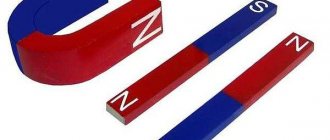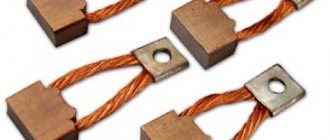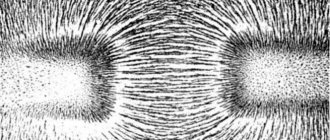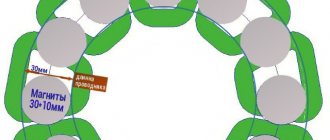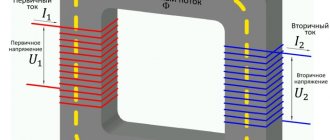Making refrigerator magnets has recently become a popular business niche. For a long time, the domestic market was saturated with products from Chinese manufacturers. However, in recent years, there has come an awareness of the fact that you can make money using magnets with virtually no initial investment or special knowledge. Small production is easier to adapt to the specific needs of consumers, in contrast to the assembly line activity of China, which leads to the production of monotonous and non-functional products.
How to produce
An absolute advantage of a business related to the production of small souvenir products, such as magnets, is a quick payback.
Of course, the production of large, expensive products promises corresponding profits, but a lot of investment is required. And you have to wait months or years for payback. You can earn money by producing refrigerator magnets in the first months.
To organize your own business you need a minimum set of equipment and materials. The ability to take photographs, work with Photoshop and design skills will be a huge plus. In general, the creative side is largely decisive, since there is competition in this area, and consumer sympathy depends on the ability to stand out from the general magnetic mass.
Master Class. 1. Hook magnets made from branches
You can hang keys, towels, ladles and other things on these branch hooks.
Materials and tools:
- A dry small but strong branch with a branch;
- Hand saw or jigsaw;
- Small neodymium magnets;
- Glue;
- Drill and drill bit equal to the diameter of the magnets;
- Acrylic paint (optional).
Instructions:
- Using a saw, cut the branch so that it looks like a hook. Then cut the branch lengthwise so that the back side is flat as shown in the photo below on the left.
- In this flat back of the branch, drill a recessed hole the size of your magnet.
- Glue the magnet into the resulting cell.
- If desired, paint the craft and cover it with matte varnish. Ready!
What are they made from?
To set up the production and production of refrigerator magnets, you need to decide on consumables. Based on the type of material, the following types of magnets are distinguished:
- Acrylic. Acrylic is a common plastic. Such magnets are easy to make, since there are special blanks - an acrylic box with a lid, into which you just need to insert a printed picture or photograph.
- Vinyl. Vinyl is a soft polymer sold in rolls or sheets. It's easier to buy magnetic vinyl with an adhesive backing. Then you will need to attach a printed and laminated picture to it.
- Clay. To make clay refrigerator magnets, polymer self-hardening or baked clay is used.
- Wooden. The wooden look looks quite original, and they are also environmentally friendly. But their creation requires a lot of time, effort and special equipment. You need a laser plotter that burns a drawing or engraving onto the working surface.
- Plaster. Gypsum is perfect for the production of a variety of volumetric types.
- Phosphor. Glow-in-the-dark magnets have become very fashionable items lately. When created, they are coated with a special phosphor powder that can draw energy from the environment and transform it into light radiation. This glow will definitely last all night.
- Sunsets. The sunset look usually refers to some kind of symbolism and is attached to clothes or bags. In addition to the acrylic form into which the image is inserted, a metal base is required. To secure the finished magnet, a special rolling press is required.
- Rubber. Magnets made of soft PVC rubber are quite in demand, but they are difficult to produce. The rubber must be poured into molds and then baked in a special oven at a temperature of about 250 degrees Celsius.
Types of magnets
What types of magnets are there? They can be of three types:
- Constant M are of natural origin. They are made from alloys of several magnetic materials.
- Temporary M exhibit their properties under the influence of an external magnetic field.
- Electromagnets consist of a coil of insulated wire on a live core.
Permanent magnets are divided into several types based on their composition:
- ferrites;
- neodymium PM;
- samarium-cobalt alloys;
- alnico;
- magnetoplasts.
Ferrites
Ceramic PM, or ferrites, are the most common type of permanent magnets. They appeared in the 60s of the last century as a result of the successful development of a new magnetic alloy. Ferrite PM retains a high level of magnetization for a long time. However, the strength of their magnetism is highly dependent on changes in ambient temperature.
For convenient use, ferrite products are produced in different shapes and sizes. Magnets are made in the form of cylinders, rings, rectangular bars and disks. Recently, ferrite magnets with eye bolts have appeared for conducting search work in both granular and aqueous environments.
Ferrite
Neodymium PM
Neodymium magnets are very strong magnets, made from an alloy of neodymium, iron and boron. The source of a constant magnetic field is a crystal structure of interconnected atoms in accordance with the formula Nd2Fe14B. PM is used in various industries, medicine, electrical engineering, electronics and everyday life.
Neodymium M
Samarium-cobalt alloys
The alloy contains a rare earth chemical element – samarium. The metal has strong magnetic properties. Samarium-cobalt magnets (SCM) are highly resistant to corrosion and temperature changes and do not require a special protective coating.
Rich samarium deposits are located in China. Mass production of SCM has been established in this country. Under certain conditions, samarium products are stronger than the most powerful neodymium magnets. SCMs are made in two types, corresponding to the chemical formulas: SmCo5, Sm2Co17.
SCM
Important! SCMs are used in almost all industries. Magnets are the basis for creating critical parts of electric motors, generators, and various electrical devices. SCMs play an important role in speaker systems, PC hard drives, etc.
Alnico
PM got its name from the abbreviation of the names of the alloy components. These are aluminum, nickel and cobalt (Alnico). It also contains iron. In addition to the fact that the alloys have a high value of residual magnetic induction (Br), they are endowed with high anti-corrosion resistance, and also retain their magnetic qualities at high temperatures (up to 5500C). The advantage of PM Alnico is that they are much cheaper than SCM.
An example of Alnico is horseshoe-shaped products. This form of the PM ensures that the poles are as close to each other as possible, which makes it possible to lift heavy metal objects.
Alnico rings
One of the properties of alnico products is that they can be easily demagnetized, while at the same time the material quickly restores residual magnetization in an external magnetic field. This phenomenon is explained by the low coercive force.
Magnetic plastics
With the development of various industrial technologies, there was a need for PM, which would be in the form of flat flexible materials. The problem was solved by spraying metal onto polymer sheet material. For this, polymers such as vinyl, polystyrene, polyamide, etc. are used. Polymer magnets are both flexible and rigid.
Flexible magnetoplast
One of the striking examples of the use of these products is the sealing frame of the inner perimeter of the refrigerator door. A magnetic plastic is placed inside the rubber frame, which tightly attracts the door to the metal surface of the refrigeration unit body.
The positive qualities of magnetoplasts include the following:
- creation of multi-pole structures;
- long service life;
- sustainable reproduction and stability of the magnetic field;
- anti-corrosion qualities;
- strength and ductility.
Electromagnet and demagnetizer
An electromagnet is a device that creates a magnetic field around a core with a wound wire. Current passes through the turns. The ferrite rod at this time becomes a powerful magnet.
The action of powerful electromagnets can be observed in steelmaking shops for processing scrap metal. An overhead crane lowers a magnet into a crowbar. The crane operator turns on the voltage, and several hundred kilograms of metal stick to the electromagnetic disk, which is then sent to the melting furnace after turning off the current.
The demagnetizer acts in the reverse order - it removes residual magnetization from parts of various devices. It is used where induced magnetic fields interfere with the operation of electrical engineering and electronics.
Note! In its design, a demagnetizer is no different from an electromagnet. The difference is that not constant, but alternating voltage is supplied to the winding coil.
We open production
Opening a business for the production of refrigerator magnets should begin with registering an individual entrepreneur. The OKVED code will depend on the type of products manufactured.
It is expected that before opening, you will analyze the competitive environment and formulate a production concept that will allow you to produce in-demand products. The concept of functionality and usefulness (reminder magnets) and the concept of warm memories (photo magnets) work great.
There is no point in renting a separate room; it is easier to adapt one room in an apartment. Then you need to purchase equipment, organize an advertising campaign and establish sales channels.
Traditional ways of promotion work well: website, landing page, group on social networks, contextual advertising. You will have to invest 20,000 - 50,000 rubles in advertising. But in the case of souvenirs, it is worth emphasizing live communication with potential buyers.
You can offer samples of finished magnets to souvenir shops and museums. They purchase products from China and will be interested in cooperation with a local entrepreneur.
It is worth recommending the products to hardware stores. When selling a refrigerator, the magnet will be given as a gift - a small thing, but it will be nice for the buyer.
Various companies and firms often order magnetic products with corporate symbols.
A great option is to make friends with the organizers of city events, festivals and exhibitions. They can order a batch of magnets with a certain symbol, but instead of paying you in cash, they will offer to advertise you during the event. It is worth agreeing to such a proposal.
And, of course, a business producing refrigerator magnets will be incomplete without its own online store.
Chemical composition of a magnet and its properties
So, let's look at what neodymium magnets are made of. Chemical formula of the magnet: Nd2Fe14B. In simple words, it includes:
- 2 neodymium atoms;
- 14 iron atoms;
- 1 bromine atom.
These are all rare earth metals. This combination gives the products incredible power, which is measured in Gauss. If ordinary magnets rarely produce more than 50 Gauss, then the strength of neodymium magnets can reach 13,500 Gauss or more. Although in most cases a magnet with a strength of 2000 Gauss is sufficient.
Properties:
- A small magnet, the size of a five-ruble coin, can withstand a weight of up to 9 kilograms.
- Neodymium magnets do not withstand very high temperatures and may lose some of their strength.
- The service life of the magnet is practically unlimited. Over a hundred years of service, he loses only 1% of his strength.
- Such products are completely safe for humans and the environment, but if used incorrectly they can harm the electromagnetic field of some devices.
The composition of the neodymium magnet alloy gives them great power and makes them reliable assistants both in everyday life and in production.
Reference! Despite their name, "rare earth" metals are not rare. They are found in all parts of the Earth. However, they are all found in small concentrations, so their extraction from the bowels of the earth is economically unprofitable for many countries.
Equipment
To be fully armed and produce magnets from various materials, you will need to purchase the following equipment and materials:
- inkjet photo printer + related products (paper, cartridges) – RUB 35,000;
- cutting plotter – 15,000 rubles;
- professional camera (we’ll talk about why it’s profitable to make photomagnets for refrigerators a little later) – 30,000 rubles;
- laminator + laminating film – 6,000 rubles;
- tools for processing – 3,500 rubles;
- paints, brushes – 3,000 rubles;
- roll of vinyl measuring 3000 by 62 cm (10 pieces) – 50,000 rubles;
- acrylic blanks for magnets (1,000 pieces) – 5,000 rubles.
Total: 147,500 rub.
Master class 5. Magnets from clothespins
Let's reveal a little life hack - magnets made from clothespins can not only store lists and bills, but also clamp bags of food as shown in the photo below. It turns out to be very convenient - I took the clothespin off the refrigerator and immediately fixed the opened bag with it.
Wooden clothespins can also hold a piece of paper on the refrigerator door and at the same time clamp something between the teeth.
Clothespins can be painted, decorated with glitter, covered with colored tape or appliques, or decorated using decoupage technique, following the following simple instructions.
Materials and tools:
- Wooden or bamboo clothespins (you can take regular or decorative ones for scrapbooking);
- Scissors;
- Double-layer napkin with a pattern;
- One glue brush and one varnish brush;
- PVA glue;
- Glue "Moment" or its equivalent;
- Matte acrylic varnish;
- Small magnets.
Instructions:
- Separate the patterned layer from the napkin, then cut out a strip of it slightly larger than the end of a clothespin.
- Glue the cut strip onto one end of the clothespin using PVA glue, then use a brush to carefully spread the glue over the napkin. Leave the craft to dry.
- Trim the excess napkin with scissors.
- Coat the clothespin with varnish and wait about 2 hours for it to dry.
- Glue a magnet to the other end of the clothespin. Voila! The craft is ready!
Technology
The manufacturing technology of different refrigerator magnets differs significantly from each other.
It is better to start a business with the production of vinyl and acrylic - they are the easiest to create.
Acrylic blank + printed image = finished magnet. To make vinyl, you need to print out a picture, laminate it, stick it on an adhesive vinyl backing and cut out the finished product with a plotter.
Plaster and clay magnets are easy to produce, but you will need to purchase additional molds and be prepared to paint the product yourself or hire an artist separately. If baked clay is used, it can be placed in an oven preheated to 100 - 130 degrees. But a microwave is not suitable for baking clay. A gypsum product, on the contrary, needs to be cooled.
It is important that the back side of the volumetric magnets is perfectly flat for a tight connection with the magnetic base (vinyl).
The cost of wooden types is quite high, plus you need to purchase a laser plotter (from 70,000 rubles). To create rubber and ceramic magnets, you will have to rent a separate room and install a baking oven. This is worth thinking about when the business gains good momentum.
Where to buy a neodymium magnet?
Neodymium magnets of various shapes, sizes and holding forces are offered by the company, whose central store-warehouse is located in St. Petersburg. To familiarize yourself with the range and detailed technical characteristics of magnetic products made of neodymium, we suggest following the link.
Types and shape of neodymium magnets
Types of magnets available for ordering through the website:
- disks;
- rings;
- rectangles;
- squares;
- rods (cylinders);
- discs and plates with a countersunk hole for a screw.
A neodymium disk is a universal form of magnetic fastener that has an adhesive force of up to 55 kg and is used as a holder or retainer. Its variety - a disk with a hole for a self-tapping screw - is used when it is necessary to fix a magnetic holder on a wooden, plastic or concrete surface (wall, cabinet, panel) for subsequent storage of keys or other small iron items.
Magnets in the shape of a ring (washer) have found application in souvenirs, advertising products, products with magnetic locks and clamps. They can be tied to a rope and used to clean liquids and bulk products, and search for hardware in water. Magnets rods (rods) and rectangles are widely used to create household magnetic fasteners, door latches, as well as in modeling, advertising, and electronics.
Most consumers buy neodymium magnets in China, since this country is the leader in the extraction and production of neodymium. Today there is no need to order them on AliExpress and wait a long time for delivery. Wholesale delivers these products to Russia, and the price of neodymium magnets is no higher than on the Chinese website. Small disk magnets with a diameter of 3 to 10 mm can be purchased at prices ranging from 5 to 20 rubles. Medium models with a diameter of 20-30 mm will cost no more than 100 rubles. The cost of the most powerful and largest magnets does not exceed 2000 rubles.
Payback
You will have to invest about 150,000 - 200,000 rubles to open a business producing vinyl and acrylic refrigerator magnets.
1 roll of vinyl yields approximately 2,000 magnets. It is realistic to produce and sell about 8,000 per month.
1 magnet sells for 20 – 40 rubles. It turns out that you can earn 160,000 - 320,000 rubles. Minus monthly expenses for materials and advertising, the net profit will be 100,000 - 150,000 rubles. Payback is achieved in 2 – 3 months.
Legends
The history of the discovery of a natural object and the subsequent study of its qualities, according to legend, developed simultaneously on several continents.
Ancient Greece
The mythical legend says that the event occurred more than 4 thousand years ago, when a Greek shepherd named Magnus was guarding a flock of sheep in Crete. The character of the legend discovered that the metal tip of his staff and the nails on the soles of his boots were attracted to the large black stone on which he stood.
This type of rock came to be called “Magnus stone” or simply “magnet”. So, even 2 millennia BC, people gained knowledge about the properties of some stones to attract iron objects.
Ancient America
The magnet appeared in Central America even earlier than in Eurasia. This is evidenced by a historical find made on the territory of the modern state of Guatemala. During excavations, ancient sculptures were discovered - “fat boys”, which symbolize fertility and a well-fed life. The figures are entirely made of magnetic rock.
Ancient China
Chinese legends form tales about the use of a magnet by a mythical figure. The great Emperor Huang Di, following what is written in the annals about attracting stones, used the first compass during the battle. It is known that a device in the form of an iron spoon on a smooth magnetic surface was used by the Han Dynasty for predictions.
Eurasia
European legends tell about the discovery made by jewelry maker Flavio Gioia. He was the first on the continent to invent a magnetic compass. The man was from a low class, but loved the daughter of a rich fisherman. Her father was against such an alliance and set a condition: Flavio must learn to swim in a straight line in the night fog. The resourceful master noticed that a cork with a black stone placed on it, placed in a plate of water, always tends in one direction. So he was able to complete the difficult task.
Adviсe
Some practical advice for entrepreneurs who have decided to start producing refrigerator magnets:
- Create entire sets on different topics. It is common to see magnetic alphabets in families with children. But you can develop this theme and come up with seasons, magnets - road signs, magnets - inhabitants of the underwater world, etc. Such educational sets are perfectly compatible with children's boards.
- The magnet sets will also appeal to adults. Magnets - calendars will decorate the environment; reminders and wishes will strengthen a warm family or friendly atmosphere. For corporate clients, you can develop a series of magnets - tasks.
- Making magnets is unthinkable without a creative streak. Therefore, the designer and the artist are absolutely useful collaborators.
- It is extremely profitable to create photomagnets. For a photo magnet with a picture of their child in a funny cartoon frame, parents are willing to pay 300–500 rubles. Despite the fact that the cost of such a thing is 8 - 10 rubles (if you use an acrylic blank and a personal professional camera). Parents know that they usually take group and individual photos in kindergartens. But photos on a magnet are rare. Meanwhile, parents will not only hang the photomagnet at home, but also give it as a gift to grandmothers, aunts and other interested individuals. This chance should not be missed. Talk to the heads of kindergartens in your city, offer cooperation for a percentage of sales.
Conclusion
Making refrigerator magnets will become a stable source of good income if you approach the process creatively and gain many large clients ordering individual products. With a fairly modest initial investment, quick and stable profits are quite possible.
Does this business seem promising to you? Which magnets do you think will sell best? Write your opinion in the comments and don’t forget to rate the article.
Rate this article:
[Total: 3 Average: 5/5] (Article Rating: 5 out of 5)
Author of the article Elena Simakina Lawyer
Why does a permanent magnet have a magnetic field?
In 1820, the Danish physicist Hans Oersted, while studying electrical phenomena, discovered that if a magnetic compass needle was placed near a metal wire, then when the electric current was turned on, the needle deviated by a noticeable angle. Although he could not explain this phenomenon, after the publication of these results, the French scientist Andre-Marie Ampère suggested that the movement of electric charges in a wire - an electric current - leads to the appearance of a magnetic field. Interaction occurs and in practice the needle is deflected.
Rice. 2. Ampere's hypothesis. Ampere's model for internal currents in magnets
Ampere used the same idea to explain the nature of the magnetic field of permanent magnets. According to his theory, the magnetic field appears due to the presence in magnets of continuously circulating circular currents, which are equivalent to small magnets. These currents add up, reinforce each other and create a common magnetic field inside and outside the magnet. A magnet as a whole is a set (sum) of these magnets.
Our planet is a huge permanent magnet. The schematic diagram of the Earth's permanent magnet, which creates its magnetic field, is similar to the nature of an ordinary, natural magnet. The Earth's core has an outer shell of molten metals (iron, nickel and a number of impurities) at a temperature of more than 4000 K0. The hot mass, consisting of a mixture of charged particles, rotates along with the Earth. As a result, continuously circulating flows and vortices arise, which are the main reason for the appearance of the Earth's magnetic field.


